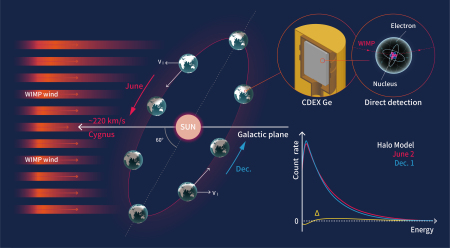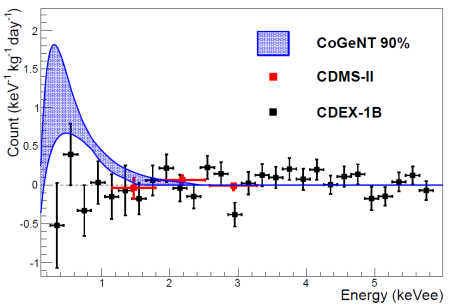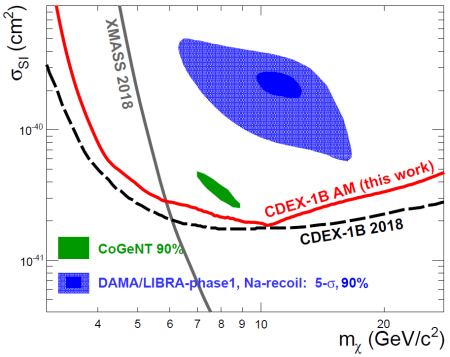On November 25th, CDEX (China Dark matter EXperiment) collaboration, led by Tsinghua University, published an article entitled “Search for Light Weakly-Interacting-Massive-Particle Dark Matter by Annual Modulation Analysis with a Point-Contact Germanium Detector at the China Jinping Underground Laboratory” in Physical Review Letters (Phys. Rev. Lett. 123, 221301, 2019). In this work, the 90% C.L. allowed regions implied by the DAMA/LIBRA and CoGeNT AM-based analysis are excluded at >99.99% and 98% confidence level (C.L.), respectively. These results correspond to the best sensitivity at mχ<6 gev among the annual modulation measurements of weakly interacting massive particles (wimps, denoted as χ) to date.
Compelling evidence from astronomical observations has demonstrated the existence of dark matter in the Universe, which plays a very important role in understanding the origin of mass and the evolution of the Universe. There are three kinds of approaches to detect dark matter: direct detection, indirect detection, and accelerator-driven dark matter production. WIMPs, the most popular dark matter candidate, are hypothetical massive particles that could interact with ordinary matter via weak force processes. CDEX collaboration aims at direct searches of light WIMPs with p-type point contact germanium detectors, by detecting the deposited energies when the incident WIMP bombards the target nucleus of the detector and is then scattered off by the nucleus.
In direct laboratory searches of WIMPs conducted with WIMP-nucleus (χ-N) elastic scattering, positive evidence of WIMPs can be established by time-integrated spectrum analysis, annual modulation analysis and directional analysis. The annual modulation (AM) is that due to the Earth’s revolution, the detector’s motion relative to the galaxy dark matter distribution will lead to periodic and extremely tiny changes in the χ-N scattering event rates. The AM analysis can provide smoking-gun signatures for WIMPs independent of background modeling. Within the astrophysical dark matter halo model, the expected χ-N rates have distinctive AM features with maximum intensity in June and a period of one year. The principle of AM measurement is depicted in Figure 1. Positive results were concluded at significance of 12.9σ and 2.2σ from AM-based analysis of DAMA/LIBRA and CoGeNT experiments, respectively. However, these interpretations are challenged by integrated rate experiments with liquid xenon, cryogenic bolometer, and ionization germanium detectors.

Figure 1 The principle of the AM measurement. Left: Due to the earth's revolution, the relative velocity of the dark matter and the detector (the scattering event rates) will change periodically, and the relative velocity (the scattering event rates) will reach its maximum in June, its minimum in December, and the modulation period is one year. Right: The point-contact germanium detector used in CDEX and the principle of dark matter direct detection. The red (blue) line indicates the nuclear recoil energy spectrum caused by the 8 GeV WIMP scattering with the detector target (germanium nucleus) on June 2 (December 1). The difference between the two (yellow line) is the expected modulation amplitude in χ-N rates.
The CDEX experiment, located in the China Jinping Underground Laboratory (CJPL) with about 2400 m of rock overburden, utilizes p-type point contact germanium detectors for dark matter direct detection. The experimental sensitivities of the AM measurements are enhanced by the long exposure time, as well as good operation stability and low energy threshold of the germanium detector target. The low analysis threshold of about 200 eVee (“eVee” represents electron equivalent energy) implies AM studies with germanium can complement the liquid xenon results. It provides an alternative probe to the allowed parameter space of DAMA/LIBRA (with model dependence due to different target isotopes) and CoGeNT (with a model-independent comparison, since both use germanium as target) and extends the reach of AM test to lower mχ.
New results on light weakly interacting massive particle (WIMP) searches with annual modulation (AM) analysis on data from a 1-kg mass p-type point-contact germanium detector of the CDEX-1B experiment at CJPL have been reported. Datasets with a total live time of 3.2 yr within a 4.2-yr span are analyzed with analysis threshold of 250 eVee. Limits on χ-N spin-independent cross sections as function of WIMP mass at 90% C.L. are derived using the dark matter halo model. Within the context of the standard halo model, the 90% C.L. allowed regions implied by the DAMA/LIBRA and CoGeNT AM-based analysis are excluded at >99.99% and 98% C.L., respectively. These results correspond to the best sensitivity at mχ<6 gev among wimp am measurements to date.


Figure 2 top: Best-fit solutions of modulation amplitude at phase φ=152.5 d. The distributions show consistency with null results, i.e., no significant modulation signatures. bottom: Limits at 90% C.L. from CDEX-1B AM-analysis (red) on spin-independent WIMP-nucleon cross section. The results refute the 90% C.L. allowed regions inferred from AM-based analysis of DAMA/LIBRA-phase1 low-mχ (Na-recoil) and CoGeNT experiments, providing an exclusion at >99.99% and >98% C.L., respectively.
The CDEX-1B experiment provided unique low threshold (250 eVee,) and stable (3.2 yr of live time) data for sensitive AM analysis results without energy-dependent background model assumptions. The CDEX dark matter program continues taking data at CJPL, expanding to use germanium detector arrays immersed in liquid nitrogen acting as cryogenic coolant and shield against ambient radioactivity. R&D efforts on the germanium detector fabrication, and further radiation background reduction, are being pursued. Scaled-up experiment toward target mass of 100 kg is being prepared at CJPL-II.
Dr. Litao Yang, postdoc in the Department of Engineering Physics, is the first author of this paper. Prof. Qian Yue and Associate Prof. Hao Ma are the co-corresponding authors. This work was supported by the National Key Research and Development Program of China, the National Natural Science Foundation of China, the Dark Matter Experimental Platform of Tsinghua University and the Tsinghua University Initiative Scientific Research Program.
The original link: https://journals.aps.org/prl/abstract/10.1103/PhysRevLett.123.221301

